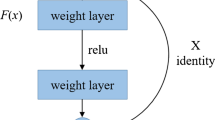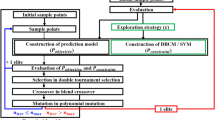Abstract
Constrained optimization problems (COPs) with multiple computational expensive constraints are commonly encountered in simulation-based engineering designs. During the optimization process, the feasibility analysis of the intermediate solutions depends on the computational simulations will be computationally prohibitive. To relieve this computational burden, an active-learning probabilistic neural network (AL-PNN) classification modeling approach is proposed to build a classifier for quickly analyzing the feasibility of the intermediate solutions. In the proposed AL-PNN approach, an interesting region tracking strategy is developed to locate the regions that may contain part of the constraint boundary. The judge rule of the interesting region is based on whether the predicted class labels of pseudo points are different in subregions, which is generated by dividing the design space with the K-means cluster algorithm. Once the interesting region is located, the newly infill sample point used to update the PNN classification model can be obtained by a distance screening criterion. Seven numerical cases and the design of the rocket interstage section are used to demonstrate the performances of the proposed approach. The results illustrate that the proposed AL-PNN approach can provide more accurate classification results than the compared four state-of-the-art algorithms.














Similar content being viewed by others
References
Chatterjee T, Chakraborty S, Chowdhury R (2019) A critical review of surrogate assisted robust design optimization. Arch Comput Methods Eng 26(1):245–274
Wang H, Jin Y, Yang C, Jiao L (2020) Transfer stacking from low-to high-fidelity: a surrogate-assisted bi-fidelity evolutionary algorithm. Appl Soft Comput 92:106276
Ruan X, Jiang P, Zhou Q, Hu J, Shu L (2020) Variable-fidelity probability of improvement method for efficient global optimization of expensive black-box problems. Struct Multidiscip Optim 62(6):3021–3052
Zhou Q, Wu J, Xue T, Jin P (2021) A two-stage adaptive multi-fidelity surrogate model-assisted multi-objective genetic algorithm for computationally expensive problems. Eng Comput 37:623–639
Zeng P, Li T, Chen Y, Jimenez R, Feng X, Senent S (2020) New collocation method for stochastic response surface reliability analyses. Eng Comput 36:1751–1762
Vasu A, Grandhi RV (2014) Response surface model using the sorted k-fold approach. AIAA J 52(10):2336–2341
Hu J, Zhou Q, McKeand A, Xie T, Choi SK (2021) A model validation framework based on parameter calibration under aleatory and epistemic uncertainty. Struct Multidiscip Optim 63(2):645–660
Qian J, Yi J, Cheng Y, Liu J, Zhou Q (2020) A sequential constraints updating approach for Kriging surrogate model-assisted engineering optimization design problem. Eng Comput 36:993–1009
Viana FAC, Simpson TW, Balabanov V, Toropov V (2014) Special section on multidisciplinary design optimization: metamodeling in multidisciplinary design optimization: how far have we really come? AIAA J 52(4):670–690
Jiang C, Hu Z, Liu Y, Mourelatos ZP, Gorsich D, Jayakumar P (2020) A sequential calibration and validation framework for model uncertainty quantification and reduction. Comput Methods Appl Mech Eng 368:113172
Jiang C, Qiu H, Yang Z, Chen L, Gao L, Li P (2019) A general failure-pursuing sampling framework for surrogate-based reliability analysis. Reliab Eng Syst Saf 183:47–59
Zhou Q, Shao X, Jiang P, Zhou H, Shu L (2015) An adaptive global variable fidelity metamodeling strategy using a support vector regression based scaling function. Simul Model Pract Theory 59(12):18–35
Pal M, Deswal S (2011) Support vector regression based shear strength modelling of deep beams. Comput Struct 89(13):1430–1439
Karamichailidou D, Kaloutsa V, Alexandridis AJRE (2021) Wind turbine power curve modeling using radial basis function neural networks and tabu search. Renew Energy 163:2137–2152
Safarpoor M, Shirzadi A (2021) Numerical investigation based on radial basis function–finite-difference (RBF–FD) method for solving the Stokes–Darcy equations. Eng Comput 37:909–920
Rashid K, Ambani S, Cetinkaya E (2013) An adaptive multiquadric radial basis function method for expensive black-box mixed-integer nonlinear constrained optimization. Eng Optim 45(2):185–206
Zhai Z, Li H, Wang X (2020) An adaptive sampling method for Kriging surrogate model with multiple outputs. Eng Comput. https://doi.org/10.1007/s00366-020-01145-1
Asadi A, Bakhtiyari AN, Alarifi IM (2020) Predictability evaluation of support vector regression methods for thermophysical properties, heat transfer performance, and pumping power estimation of MWCNT/ZnO–engine oil hybrid nanofluid. Eng Comput. https://doi.org/10.1007/s00366-020-01038-3
Jiang C, Qiu H, Gao L, Wang D, Yang Z, Chen L (2020) Real-time estimation error-guided active learning Kriging method for time-dependent reliability analysis. Appl Math Model 77:82–98
Basudhar A, Dribusch C, Lacaze S, Missoum S (2012) Constrained efficient global optimization with support vector machines. Struct Multidiscip Optim 46(2):201–221
Basudhar A, Missoum S, Sanchez AH (2008) Limit state function identification using support vector machines for discontinuous responses and disjoint failure domains. Probab Eng Mech 23(1):1–11
Singh P, Van Der Herten J, Deschrijver D, Couckuyt I, Dhaene T (2017) A sequential sampling strategy for adaptive classification of computationally expensive data. Struct Multidiscip Optim 55(4):1425–1438
Basudhar A, Missoum S (2010) An improved adaptive sampling scheme for the construction of explicit boundaries. Struct Multidiscip Optim 42(4):517–529
Suresh S, Dong K, Kim HJ (2010) A sequential learning algorithm for self-adaptive resource allocation network classifier. Neurocomputing 73(16–18):3012–3019
Le Chau N, Dao T-P (2020) An efficient hybrid approach of improved adaptive neural fuzzy inference system and teaching learning-based optimization for design optimization of a jet pump-based thermoacoustic-stirling heat engine. Neural Comput Appl 32(11):7259–7273
Patel J, Choi S-K (2012) Classification approach for reliability-based topology optimization using probabilistic neural networks. Struct Multidiscip Optim 45(4):529–543
Harandizadeh H, Armaghani D (2020) Prediction of air-overpressure induced by blasting using an ANFIS-PNN model optimized by GA. Appl Soft Comput 99:106904
Specht DF (1990) Probabilistic neural networks. Neural Netw 3(1):109–118
Baliarsingh SK, Vipsita S, Gandomi AH, Panda A, Bakshi S, Ramasubbareddy S (2020) Analysis of high-dimensional genomic data using MapReduce based probabilistic neural network. Comput Methods Prog Biomed 195:105625
Earp S, Curtis A (2020) Probabilistic neural network-based 2D travel-time tomography. Neural Comput Appl 32(22):17077–17095
Sun Y, Chen J, Yuen C, Rahardja S (2017) Indoor sound source localization with probabilistic neural network. IEEE Trans Ind Electron 65(8):6403–6413
Zeinali Y, Story BA (2017) Competitive probabilistic neural network. Integr Comput Aided Eng 24(2):105–118
Yao Y, Wang N (2020) Fault diagnosis model of adaptive miniature circuit breaker based on fractal theory and probabilistic neural network. Mech Syst Signal Process 142:106772
Ahmadipour M, Hizam H, Othman ML, Radzi MAM, Murthy AS (2018) Islanding detection technique using slantlet transform and ridgelet probabilistic neural network in grid-connected photovoltaic system. Appl Energy 231:645–659
Crombecq K, Laermans E, Dhaene T (2011) Efficient space-filling and non-collapsing sequential design strategies for simulation-based modeling. Eur J Oper Res 214(3):683–696
Liu H, Ong Y-S, Cai J (2018) A survey of adaptive sampling for global metamodeling in support of simulation-based complex engineering design. Struct Multidiscip Optim 57(1):393–416
Author information
Authors and Affiliations
Corresponding author
Rights and permissions
About this article
Cite this article
Fang, D., Zhang, T. & Wu, F. An active-learning probabilistic neural network for feasibility classification of constrained engineering optimization problems. Engineering with Computers 38 (Suppl 4), 3237–3250 (2022). https://doi.org/10.1007/s00366-021-01441-4
Received:
Accepted:
Published:
Issue Date:
DOI: https://doi.org/10.1007/s00366-021-01441-4




